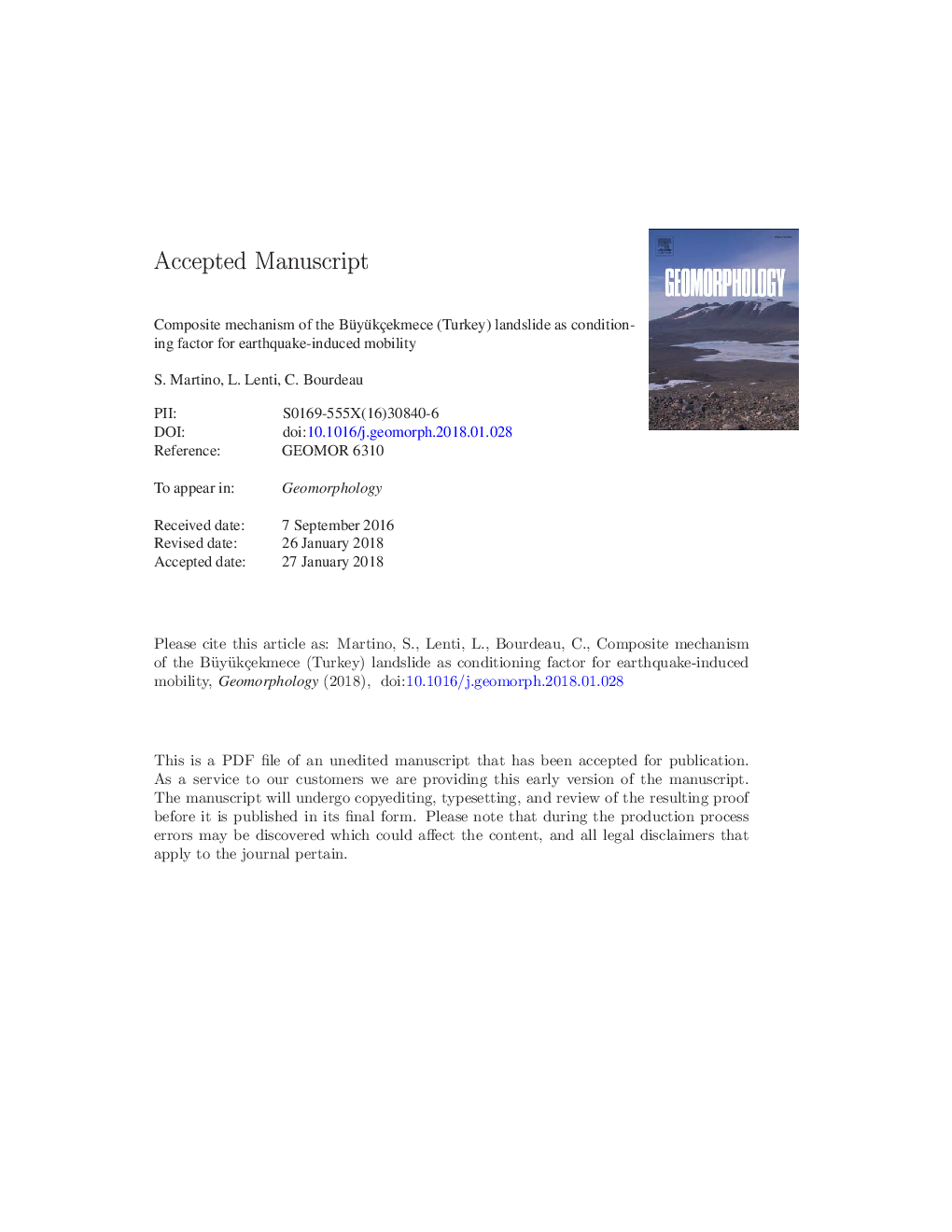| کد مقاله | کد نشریه | سال انتشار | مقاله انگلیسی | نسخه تمام متن |
|---|---|---|---|---|
| 8908072 | 1635342 | 2018 | 56 صفحه PDF | دانلود رایگان |
عنوان انگلیسی مقاله ISI
Composite mechanism of the Büyükçekmece (Turkey) landslide as conditioning factor for earthquake-induced mobility
دانلود مقاله + سفارش ترجمه
دانلود مقاله ISI انگلیسی
رایگان برای ایرانیان
کلمات کلیدی
موضوعات مرتبط
مهندسی و علوم پایه
علوم زمین و سیارات
فرآیندهای سطح زمین
پیش نمایش صفحه اول مقاله

چکیده انگلیسی
Earthquake-induced displacements of landslides are significantly conditioned by their 1D and 2D interactions with seismic waves, as currently proven by several studies. Nevertheless, the role of a more complex geological setting, responsible for a heterogeneous composition of the landslide mass, can significantly influence these phenomena. The heterogeneity can also depend on multiple phases of the landslide activity, responsible for dislodging the whole landslide mass into submasses, each one delimited by secondary scarps and characterized by individual mobility. Hence, in the framework of the European project “MARSite - Marmara Supersite: new directions in seismic hazard assessment through focused Earth observation in the Marmara Supersite”, the Büyükçekmece landslide, located approximately 30Â km W of Istanbul (Turkey), was considered as a case study. This landslide involves a large mass of approximately 140 million cubic metres, composed of silty clays, tuffs and sands ascribable to Cenozoic geological formations. The landslide is characterized by multiple phases of activity with a composite rototranslational mechanism, which created seven submasses delimited by secondary scarps. The scheme of water circulation in the landslide slope, based on piezometer data as well as on a geological survey, accounts for two flow nets: the first, shallower flow net is located in superficial sandy deposits, outcropping in the dislodged landslide submasses; the second, deeper flow net is located in the main sliding surface. A slope stability analysis following a global limit equilibrium approach provided a distribution of the pseudostatic coefficient vs. pore water pressure. The results show that the stability of the landslide submasses increases moving downslope, and reactivations are expected in the case of earthquakes with a return period between 475 and 2475Â yr, according to the local seismic hazard. Dynamic numerical modelling was also performed using the stress-strain finite difference code FLAC 7.0 to derive the distributions of horizontal displacements vs. characteristic period ratios, defined as the period due to depth (Ts) and total length (Tl) of the landslide mass over the earthquake characteristic period (Tm). The obtained results indicate that an effective characteristic period of the landslide (Tlâ), related to the length of a single counter-slope tilted submass, can provide a more correct explanation for the effect of seismic wave interactions on earthquake-induced displacements. This result indicates that the earthquake-induced mobility of the Büyükçekmece landslide is strongly conditioned by its composite rototranslational mechanisms. In general, these results indicate that landslide evolution can induce a change over time for the characteristic periods related to the dimensions of the dislodged landslide portions and then modify its interactions with seismic waves.
ناشر
Database: Elsevier - ScienceDirect (ساینس دایرکت)
Journal: Geomorphology - Volume 308, 1 May 2018, Pages 64-77
Journal: Geomorphology - Volume 308, 1 May 2018, Pages 64-77
نویسندگان
S. Martino, L. Lenti, C. Bourdeau,